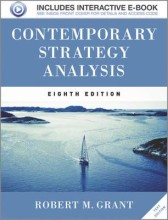Summary: Contemporary Strategy Analysis Text Only | 9781119941880 | Robert M Grant
- This + 400k other summaries
- A unique study and practice tool
- Never study anything twice again
- Get the grades you hope for
- 100% sure, 100% understanding
Read the summary and the most important questions on Contemporary Strategy Analysis Text Only | 9781119941880 | Robert M. Grant
-
1 The concept of strategy
This is a preview. There are 8 more flashcards available for chapter 1
Show more cards here -
What is the difference between Corporate and Business Strategy
Corporate: Where do we compete? which markets and industries
Business: How do we compete? Firm in market -
How does strategy assists in effective management of organizations?
1. Supports in decision making (smaller scope)
2. Facilitates coordination while managing a firm
3. Focuses organizations on long term goals (strategy as target) -
What are three types of strategies according to Mintzberg?
Intended strategy (by top management)
Realized strategy (executed strategy)
Emerged strategy (emerged strategy due to changing circumstances) -
Three common characteristics of strategy in military and business spheres
- They are important
- They involve a significant commitment of resources
- They are not easily reversible
-
2 Goals, Values, and Performance
This is a preview. There are 1 more flashcards available for chapter 2
Show more cards here -
What are the two main profit measures? And which one is preferred? Why?
Accounting Profit (not taking capital into account)
Economic profit (profit after all inputs (including capital) have been paid)
Economic profit is preferred because the two main advantages:
1. It raises the bar for managers: many times, when capital is included, healthy profits disappear.
2. It improves the allocation of capital between different business of the firm -
What is wrong with shareholder value maximization?
1. Shareholder value can increase in short term due to market effects due to e.g. annual reports. Managers can be triggered to maximize short term earnings through financial manipulation rather than by growing the firm's operating profits.
Manipulation can be: earnings smoothing, asset sales, adjustments to financial structures.
This short term view will have a negative impact on long term profitability of the firm.
Ironically, this will decrease the shareholder value later.
Stakeholder value should therefore be preferred: Long term view: maximizing enterprise value rather than maximizing shareholder value. -
Which kind of companies will have a higher value on the long term? (financial/measurable balanced scorecard goal focused or the ones less focused on financial goals and performance targets) Why?
Less focused on financial targets / balanced scorecards
Profit can be only made when a it is understand on which bases profit is made. Companies who have an ambitious goal often make more profit because the goal / strategy target. Provides a vision across the company -
3 Industry Analysis: The fundamentals
This is a preview. There are 6 more flashcards available for chapter 3
Show more cards here -
What are the three factors of the industry environment influencing profits earned by a firm
1. Bargaining power of industry members towards suppliers and buyers
2. Intensity of competitors
3. Value of the product to the customers -
Discuss the buyer power force of porter
Price sensitivity
1. cost of product relative to total cost
2. product differentiation
3. Competition between buyers
Bargaining power
1. size and concentration of buyers relative to producers
2. buyers' switching costs
3. buyers' information
4. buyers'ability to backward integrate -
Discuss the threat of entry force of porter
Capital requirements
economies of scale
absolute cost advantages
product differentiation
access to distribution channels
government and legal barriers
retaliation by established producers
- Higher grades + faster learning
- Never study anything twice
- 100% sure, 100% understanding
Topics related to Summary: Contemporary Strategy Analysis Text Only
-
Analyzing resources and capabilities
-
Organization Structure and Management Systems ( op 14-09)
-
Industry evolution and Strategic Change
-
Technology-based Industries and the Management of Innovation 12 Global Strategy and the Multinational Corporation 13 Diversifi cation Strategy 14 Implementing Corporate Strategy: Managing the Multibusiness Firm 15 External Growth Strategies: Mergers, Acquisitions, and Alliances 16 Current Trends in Strategic Management
-
Project organizations and platforms
-
R&D- and technology strategies
-
Managing Knowledge and learning

































